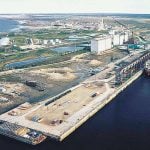Acute heart failure is a rare but dramatic cause of sudden death in horses.
Perhaps its most famous victim is Hickstead, a Canadian Olympic hero whose death in 2011 shocked the show jumping world.
The bay stallion collapsed suddenly and died after a competition in Verona, Italy. The event was broadcast around the world and immortalized on YouTube. This was a mere three years after he carried Eric Lamaze to gold and silver medals at the 2008 Olympics in Beijing. He was at the prime of his career and the peak of fitness.
Read Also

Lending policy still focused on primary producers: Farm Credit Canada
Farm Credit Canada said it has not changed its business practices and remains committed to supporting all producers, after a report from an Ottawa-based media outlet claimed otherwise.
An autopsy determined that his aorta had ruptured, leading to sudden heart failure.
This dramatic cause of death is rare among racehorses, with one study attributing less than one percent of sudden deaths to aortic rupture. Although all breeds can suffer from this condition, it seems as though horses of the Friesian breed may have a genetic predisposition.
Let’s take a closer look at this im-portant structure and what can go wrong.
The aorta is the largest blood vessel leaving the heart, and it transports oxygenated blood to organs throughout the body.
In horses, it is roughly the diameter of a garden hose. The wall is thick and elastic, with similar consistency to squid rings before they are fried into calamari. This elasticity is essential to accommodate the incredible force applied to it by each heartbeat.
It is the main vessel transporting blood, and any defect can have catastrophic results. Blood leaks into the sac that surrounds the heart (pericardium) or directly into the chest, depending on the exact location of the rupture.
In the former situation, this leaked blood compresses the heart and prevents it from filling, which ultimately leads to death. In the latter, the horse bleeds into the chest.
Veterinarians still don’t understand why aortic ruptures occur.
Documented cases suggest that breeding stallions are affected more often than other types of horses.
As well, there is an apparent predisposition in the Friesian horse breed. A 2013 study published in the Equine Veterinary Journal by Margreet Ploeg at Utrecht University in the Netherlands investigated 24 Friesian horses that died of this condition.
There were two surprising findings in this study:
- There was no evidence of prior dilation, also called an aneurysm, which would explain the rupture.
- The rupture in some horses connected into the pulmonary artery, which is the main blood vessel that takes “dirty blood” to the lungs for oxygenation.
Some of these horses apparently lived for several weeks with this condition, only to succumb to chronic heart failure at a later time. They experienced non-specific illness such as fever, colic, edema, rapid heart rate, heart murmurs and jugular vein pulsation.
The remaining horses died suddenly, just as Hickstead did.
This study will help change the dogma that all aortic ruptures cause sudden death.
The same researchers uncovered a unique pattern of changes in a follow-up study that examined the microscopic appearance of the rupture sites. There was evidence of tissue death and connective tissue disorganization at these sites, which suggests that structural abnormalities in the blood vessel wall predispose it to rupture.
Because of their narrow genetic pool, Friesians likely have a genetic predisposition to developing this condition. Unlike the general horse population, sex is not a predisposing factor among Friesians.
As well, age-related degeneration is unlikely because most horses in this study were less than 10 years old.
The Fenway Foundation for Friesian Horses is collecting detailed autopsy information from deceased horses to better understand aortic rupture and other health conditions in this breed. Information about the program can be found on the organization’s website at www.fenwayfoundation.com.
Aortic ruptures are a rare cause of death in any breed of horses, but it is important to recognize it as a possibility.
Diagnosing the condition at autopsy requires careful examination of the heart and associated blood vessels to identify the tear.
Unfortunately, diagnosis in living horses remains a challenge, but studies in Friesians and other breeds are helping us learn more about how and why this great blood vessel ruptures.














